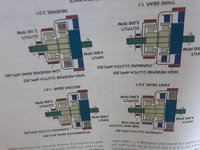Probability
Full Member
- Joined
- Jan 26, 2012
- Messages
- 432
An interesting problem I have encountered. I have a automatic transmission and I don't want to dismantle it to manually work out the gear ratios. Why do I want to do this anyway? Well, diagnostics cost money and time is money, so the faster and more accurately a diagnosis can be carried out the better for the customer.
I know that gear ratios can be calculated from (Driven/Driver) counting the number of teeth on each pulley, and I've also understood that the output (rpm) divided by the input (rpm) will calculate the gear ratio, although the math looks different.
Suppose then that I had a planetary gear set and first gear was selected. The number of teeth on the Sun gear and the number of teeth on the planet gear calculate to a ratio of 2.5:1. This information is given. The input shaft speed is 4800 rpm and the output shaft speed is 2800 rpm.
Creating a mathematical model...
(Input speed + output speed/output speed) = (4800 + 2800)/(2800) = 2.7:1
Now the question says it is 2.5:1.
Now I also believe that something else is going on inside that planetary gear set before the output speed is calculated because if I divide (4800/2.5) = 1920 rpm, and if I then divide (4800/1920) = 2.5:1
With this in mind it seems something else is also going on in the planetary gear set before the output speed becomes final. (I don't know what that is yet)
Without getting too technical, Newton said that for every action there is an equal and opposite reaction, so for now if possible I'd like to know how I could "reverse" engineer the gear ratio 2.5:1 to produce the mathematical model to prove it works!
I know that gear ratios can be calculated from (Driven/Driver) counting the number of teeth on each pulley, and I've also understood that the output (rpm) divided by the input (rpm) will calculate the gear ratio, although the math looks different.
Suppose then that I had a planetary gear set and first gear was selected. The number of teeth on the Sun gear and the number of teeth on the planet gear calculate to a ratio of 2.5:1. This information is given. The input shaft speed is 4800 rpm and the output shaft speed is 2800 rpm.
Creating a mathematical model...
(Input speed + output speed/output speed) = (4800 + 2800)/(2800) = 2.7:1
Now the question says it is 2.5:1.
Now I also believe that something else is going on inside that planetary gear set before the output speed is calculated because if I divide (4800/2.5) = 1920 rpm, and if I then divide (4800/1920) = 2.5:1
With this in mind it seems something else is also going on in the planetary gear set before the output speed becomes final. (I don't know what that is yet)
Without getting too technical, Newton said that for every action there is an equal and opposite reaction, so for now if possible I'd like to know how I could "reverse" engineer the gear ratio 2.5:1 to produce the mathematical model to prove it works!

